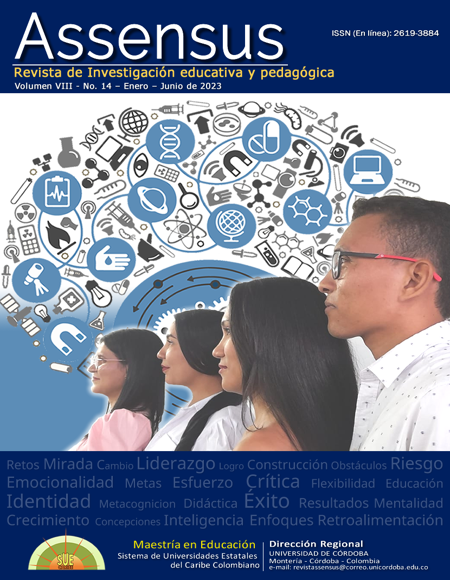Sexual abuse risk´s factors for kids between 2 to 5 years old in a child development centers
Factores de riesgo de abuso sexual en niños y niñas de 2 a 5 años en centros de desarrollo infantil

This work is licensed under a Creative Commons Attribution-ShareAlike 4.0 International License.
The Assensus journal has a Creative Commons license. The citation, use and partial or total reproduction of the contents is authorized by citing sources. For more information, see https://creativecommons.org/licenses/by-sa/4.0/deed.en
Show authors biography
Children are experiencing various situations that can put them at risk, especially in their immediate environment such as family, school, friends and neighbors. The objective was to know the risk factors to which children attending the Child Development Center of Commune V of the Municipality of Yopal are exposed, in order to analyze them and subsequently obtain results. The methodology was developed under the qualitative method, which allowed the identification of the means by which the data would be obtained and the research method chosen was the phenomenological method. The instrument used was a semi-structured interview with the participation of 3 mothers, 1 teacher and 5 children who use this service. The main risk factors identified were lack of knowledge of the concept of "sexual abuse", unqualified professionals, limited and rotation of the same and little follow-up of the entity and care of the children by third parties. Mothers and teachers show interest in being trained to be able to take preventive measures and safeguard minors.
Article visits 297 | PDF visits
Downloads
- Apraez-Villamarin, G. E. (2015). Factores de riesgo de abuso sexual infantil. Colombia forense, 2(1), 85. https://doi.org/10.16925/cf.v3i1.1179
- Chávez López, S. 2018. El Concepto de Riesgo. Recursos Naturales y Sociedad, 2018. Vol. 4 (1): 32-52. https://doi. org/10.18846/renaysoc.2018.04.04.01.0003
- %5B1%5D,evento%20y%20sus%20consecuencias%20negativas.
- Creswell, J. (2003). Qualitive inquiry and research design: among five approaches. (2ª. ed) EUA: SAGE
- Black, D. A., Heyman, R. E., & Smith Slep, A. M. (2001). Risk factors for child physical abuse. Aggression and Violent Behavior, 6(2-3), 121-188.
- https://doi.org/10.1016/S1359-1789(00)00021-5
- Bronfenbrenner, U. (1979). The ecology of Human Development. Cambridge, Harvard University Press. (Trad. Cast.: La ecología del desarrollo humano. Barcelona, Ediciones Paidós, 1987).
- Cardona, D. (2001). La necesidad de repensar de manera holística los conceptos de vulnerabilidad y riesgo “una crítica y una revisión necesaria para la gestión”.Artículo y ponencia para International Work-Conference on Vulnerability in Disaster Theory and Practice, 29 y 30 de Junio de 2001, Disaster Studies of Wageningen University and Research Centre, Wageningen, Holanda.
- Echeburúa, E. y Guerricaechevarría. C. (2020). Abuso sexual en la infancia: nuevas perspectivas clínicas y forenses. España. Ariel.
- Hein, A. (1999). Investigador Fundación Paz Ciudadana. Elaboración propia sobre la base las estadísticas de aprehensiones proporcionadas por Carabineros de Chile. Anónimo. (s. f.). Modalidad Institucional para la Atención a la Primera Infancia. Muñoz Garrido V. y De Pedro Sotelo F. (2005). Educar para la resiliencia. Un cambio de mirada en la prevención de situaciones de riesgo social. Revista Complutense de Educación, 16(1), 107-124.
- ICBF (2022). Informe de gestión 2021. Portal ICBF - Instituto Colombiano de Bienestar Familiar ICBF. https://www.icbf.gov.co/informe-de-gestion-2021
- Muñoz G, V. & De Pedro, F. (2005). Educar para la resiliencia. Un cambio de mirada en la prevención de situaciones de riesgo social. Revista Complutense de Educación. 16(1), 107-124. http://sid.usal.es/idocs/F8/ART8949/munoz_depedro.PDF
- Murillo, J. A. (2020). Abuso sexual, de conciencia y de poder: hacia una nueva definición.Estudios Eclesiásticos. Revista de Investigación e Información Teológica y Canónica, 95(373), 415-440. https://doi.org/10.14422/ee.v95.i373.y2020.005
- Ley 1098 del 2006. Por la cual se expide el Código de la Infancia y la Adolescencia. Diario Oficial.
- Romero, T. (2021). La primera infancia (0-6 años) y su futuro. Políticas de primera infancia en Iberoamérica: avances y desafíos en el siglo XXI, (pp. 39-48). Metas Educativas.
- Santacreu, J, Márquez, M.O & Rubio, V.J. (2017). La prevención en el marco de la Psicología de la salud. Publicado en la revista: Psicología y salud. Veracruz, México (1997,10,81-92. Anónimo. (2001) Abuso Sexual Infantil: Manual de formación para profesionales. Madrid. Save the Children. Auto.
- UNICEF (2011). Por qué, cuándo y cómo intervenir desde la escuela ante el maltrato a la infancia y la adolescencia. (s/f). Gov.ar. Recuperado el 30 de junio de 2023, de http://www.bnm.me.gov.ar/giga1/documentos/EL004917.pdf



